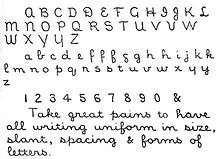Library hand

.jpg)
Library hand is a rounded style of handwriting once taught in library schools. The intention was to ensure uniformity and legibility in the handwritten cards of library catalogs. It was Melvil Dewey and Thomas Edison who developed and perfected the approved library hand to be taught in library school and used in libraries. The 1903 Handbook of the New York State Library School listed the requirements of library hand. They included legibility, speed, and uniformity. The particular type of ink, inkstands, pens, penholders, and erasers was specified. The standards for lettering were dictated in regard to size, slant, spacing, special letters and figures, and even the proper posture and position of the writer was outlined. [1] The teaching of library hand declined after the widespread introduction of the typewriter in the early 20th century.
References
External links
- Examples of library hand
- Remembrance of Catalog Cards Past
- Jayne Ringrose, The Library Hand, Cambridge University Library Special Collections blog, 13 June 2013
- Library handwriting: a guide for the use of students in the New York State Library School (The University of the State of New York, 1916) digitised by Connecticut State Library
